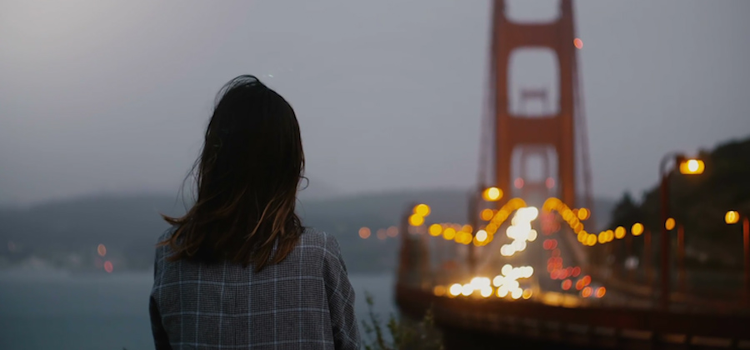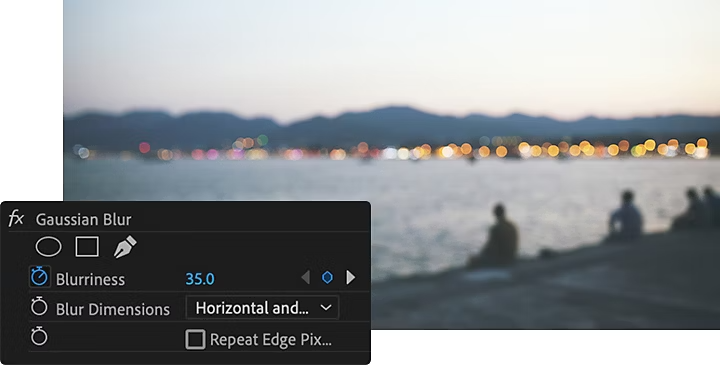VIDEO
Add flourish to videos with beautiful bokeh effects.
This shallow-depth-of-field effect adds intriguing bulbs of light to footage by shaping light in the shot. Add an aesthetic to your cinematography with bokeh.

Introduction to bokeh effects.
Bokeh (pronounced bow-kay) is a technique that photographers and cinematographers use to create dreamlike and artistically blurred effects in photos or on film. Bokeh is a Japanese word meaning “blur,” but you often hear the term used to refer to the aesthetic quality of a blurred image or how a blurred image feels when you’re looking at it.
Bokeh is associated with the golden orb shapes formed in the images from out-of-focus light. “To the average onlooker, bokeh is what is regarded as more ‘aesthetic,’ or the overall look and feel,” says filmmaker Colin Dougan.
You can create bokeh effects and bokeh video with careful and strategic use of the right lenses, or with bokeh effects in video editing software. Both are effective methods, especially with the digital tools that are available to help you add stunning effects to your footage.
Get conceptual.
Many of the principles of bokeh photography apply to bokeh in video — the best bokeh is thoughtful bokeh. Before you can begin actually capturing your shots, you need to do some compositional planning in advance if you want effective bokeh.
When you’re storyboarding a scene, imagine and plan for how you’ll use the available visual field to make for aesthetically pleasing bokeh backgrounds and foregrounds. It’s also important to ensure that whatever you select, it’s actually achievable on the day of the shoot, based on lighting, location, and requirements of the script. Conceptualizing the shot in terms of the three “-grounds” can help you do this:
- Foreground: Objects closest to the camera in a shot
- Middleground: Objects in a scene that occupy the middle space of a shot
- Background: The backdrop or framing for the middle and foreground
Any of these parts of a scene can have a bokeh effect, but when you’re planning out your scenes and shots, make notes about what should have bokeh at what time to help you create many different effects during a scene, from comedic to dramatic. For example, in many popular sitcoms like The Office, blurring then focusing on a character’s reaction to something ridiculous often drives home the punchline. Make sure to include them in your storyboard. And remember, bokeh doesn’t always have to mean a blurry background.
Creating bokeh in-camera.
You can create compelling blur and bokeh effects with many different types of lenses, but there are some specific guidelines, camera settings, and tricks to know when you’re trying to create beautiful video blurs.
Fast lenses make for great bokeh.
You need a fast lens to create good bokeh effects. This means a lens that has an aperture that can be opened up very wide, which allows for much more light to enter the camera and expose the film or hit a digital sensor. Aperture is controlled by f-stops, which are the settings that determine the aperture’s width.
For narrow depth of field, place your object closer to the lens or a specific point of focus. It blurs everything else, which allows you to play with bokeh. For really powerful bokeh effects, choose lenses that have an aperture setting of 2.8 or below. Wide apertures of 1.8 or 1.4 are even better. It can be hard to create these with automatic f-stop adjustments and aperture priority settings, so it helps to go manual with this.
Remember, aggressive bokeh can often be difficult to adjust in editing, so think about editing your footage before you shoot. “Bokeh looks really cool, but at the same time, you won’t necessarily get the full image, which can limit options when you edit,” says Dougan.
Zoom zoom zoom.
Zoom and telephoto lenses are excellent tools for bokeh. With these lenses, you can create controlled zoom effects that allow you to rack focus (change the focal point mid-shot), allowing for some wild bokeh shifts. Change the focal length by selecting a different lens and you might notice that the quality of the bokeh shifts from lens to lens.
If you decide to use autofocus, which some cinematographers do, make sure that you have a defined focus area on your camera so the sensor knows where to prioritize.
Staging and lights.
To create bokeh that catches a viewer’s attention, you need to go beyond lenses. The staging and blocking of each scene in your video will determine the image that you capture with your camera. If you’d like light bokeh effects, make sure that you have a compelling arrangement of individual light sources in the background, or even create them yourself with a lighting kit.
When attempting complex movements where you’re racking focus and altering the depth of field mid-shot, rehearsing with actors and blocking out each scene will go a long way toward capturing good blurring during your shoot.
Bokeh in the video editing bay.
Equally as effective, though a bit more time-intensive, is building bokeh effects during the post-production process. Both Adobe Premiere Pro and Adobe After Effects allow you to create focus pulls, bokeh effects, and more. But remember, when adding bokeh, think about how it complements and enhances the overall scene you’ve created.

Focus pull in Premiere Pro.
Using keyframes, masks, and the Gaussian blur effect, you can use Premiere Pro to create amazing focus pulls. While it requires a bit of micro-adjustment, using the keyframe tools lets you build a compelling change in bokeh with digital tools. However, timing and framing are still just as important in this context as when attempting to do these effects physically with a camera lens.
Plan ahead, and think about the challenges of doing things in post-production. “For every second of video, you’re dealing with at least 24 frames, and if you’re going to make a change in a video, that’s a lot of editing to do, especially if there’s going to be a lot of movement in your shot,” says Dougan.

Blur and sharpen in After Effects.
If you’re looking to do heavy blurring and bokeh work in post-production, moving footage to After Effects is helpful for effective blur. With a massive selection of different blur effects that help you affect footage in precise ways, you can capture the look and feel of different types of lenses and depth-of-field effects.
Bokeh and depth-of-field control are artisan tools, but they aren’t the only tools in the cinematographer’s toolbox. Learn more about other filmmaking concepts with these helpful tutorials.
